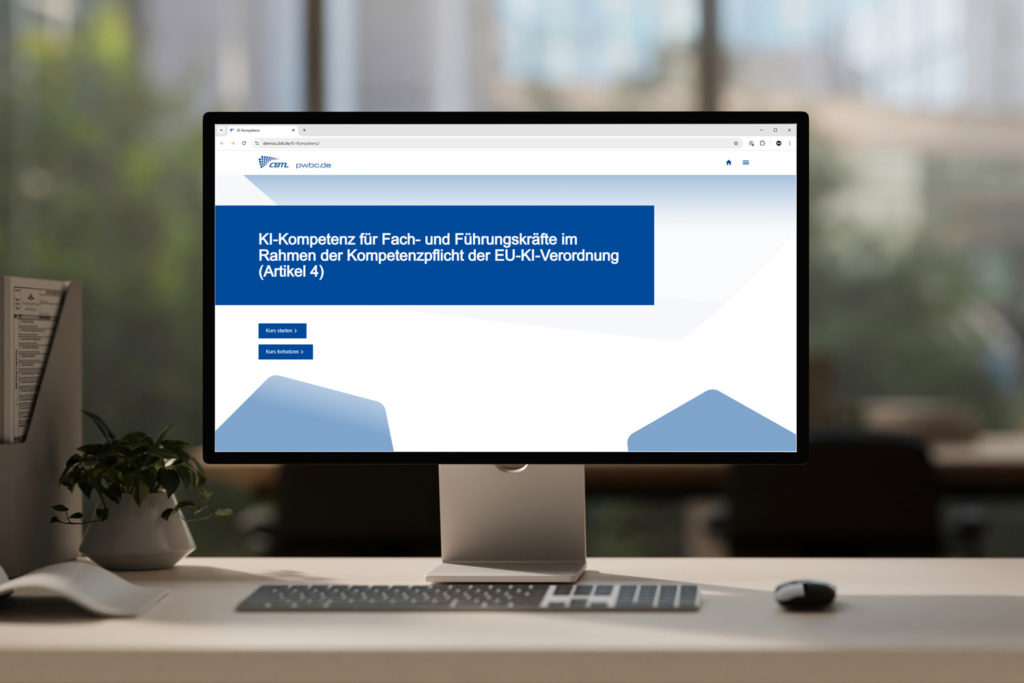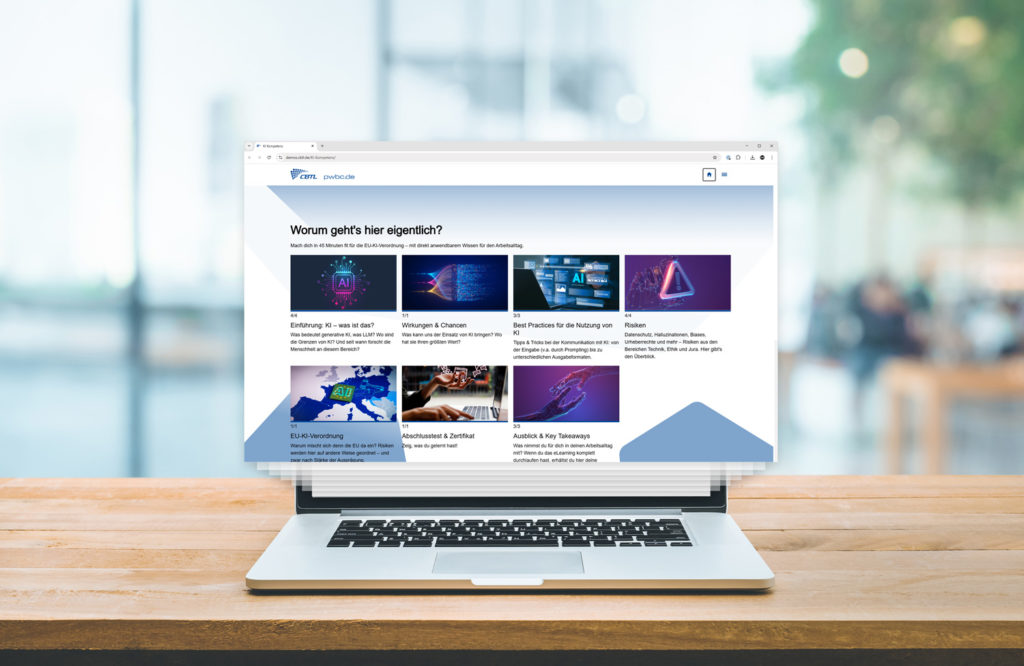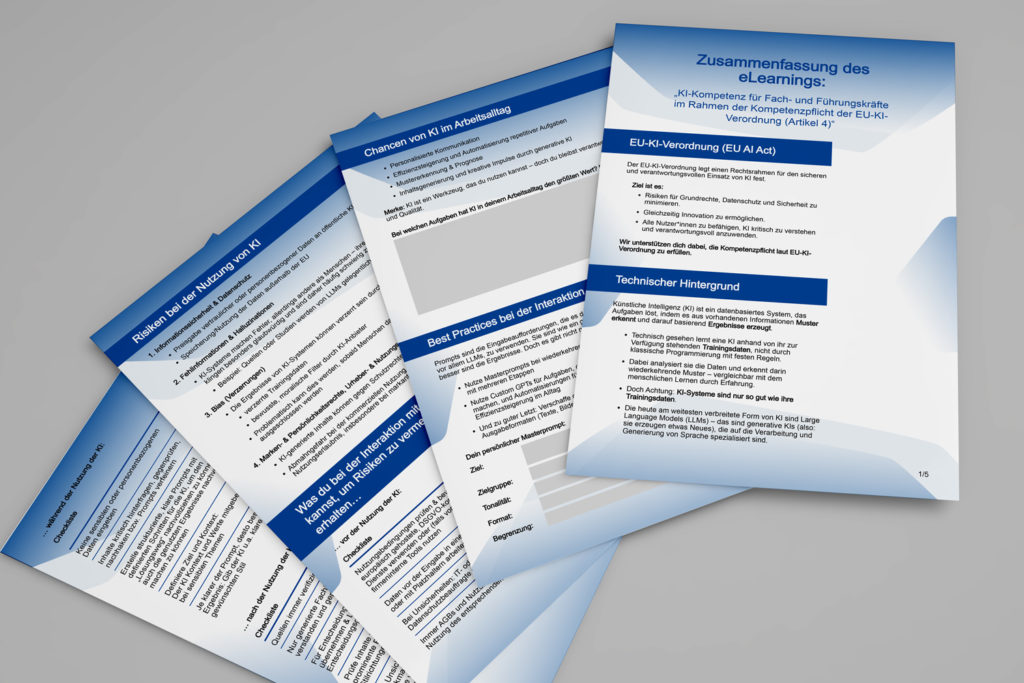Our teaching approach behind the free e-learning unit on AI competence
Today the…
Sun? Yes, probably.
It is little known to the public that it is precisely these kinds of incomplete sentence components that are used to train large language models such as ChatGPT or Claude. The models learn to recognise connections, predict probabilities and independently generate meaningful continuations.
The use of AI technologies has been the subject of intense debate for years. At the same time, it is clear that there is hardly any other subject area that is digitally available to the masses where half-knowledge is so widespread. European legislators are also responding to this: Article 4 of the EU AI Act obliges companies to provide employees with targeted training in the use of AI systems. Anyone who uses AI in a professional context should understand how it works – and how to deal responsibly with potential risks.

Our contribution: a free, interactive learning programme
To meet this need, we have developed an e-learning module on AI competence in business – accessible to all, free of charge, didactically well thought-out and close to the reality of the learners.
But how do you teach such a complex topic as AI – without overwhelming, oversimplifying, reciting the paragraphs of the EU AI Act or drifting into technical jargon or buzzwords?
Our answer: with a learning concept that focuses radically on practical relevance, storytelling and active thinking.
We impart applicable knowledge that makes a real difference – for specific situations, real challenges and the individual everyday working lives of learners. Our e-learning is not intended to overwhelm, but to enable action: with examples, thought-provoking ideas and methods that really help.
Practice instead of theory: what makes our teaching methods special
Everyday life as a stage: learning about real challenges
At the heart of our e-learning programme is a series of interactive scenarios from everyday working life. Learners accompany several main characters – real personalities with professional tasks, uncertainties and questions.
They write prompts, check the output of their AI tools for legal violations, stumble across a hallucinatory response or are faced with the question: ‘Am I even allowed to enter this information here?’
What makes it special: Learners directly observe how the main characters deal with specific challenges – they see their screens, follow decision-making processes and thus gain practical insights. It’s not just about the what, but above all about the why. This creates closeness, promotes understanding and increases relevance. Those who recognise how a topic relates to their own everyday work can not only remember content better, but also apply it in a more targeted manner. The focus is therefore not on theoretical knowledge, but on concrete practical skills.
Instead of rigid speech bubbles or changing static stock characters, dynamic, AI-generated avatars are used. They react naturally, convey emotions and create a high degree of authenticity through their appearance. This creates a learning experience that is not only contemporary but also motivating.
Expert knowledge made understandable
The e-learning course is accompanied by AI expert Patric Weiler. He addresses the challenges faced by our main characters, provides technical explanations and imparts exactly the kind of knowledge needed to work with AI confidently, efficiently and responsibly.

Active thinking instead of passive consumption
In addition to the scenes from everyday working life, learners are repeatedly asked specific questions: ‘When do you think the idea of AI originated?’, ‘What would you do?’, ‘What problems stand out here?’
Digital learning content should not be limited to digital PDFs. Our goal is to generate mental processing depth – through reflection, thought-provoking questions, simulations, interactive decision-making processes and meaningful feedback. We avoid trivial questions and instead focus on didactically well-thought-out feedback that does not demotivate learners when they give wrong answers, but rather encourages them in a targeted manner. Instead of merely consuming information, learners actively think for themselves, which not only helps them learn more effectively, but also strengthens a key competence in dealing with generative AI systems: their own judgement.
Securing transfer: The personal learning diary
Learning often remains abstract if there is no connection to one’s own everyday life. That is why we encourage learners to reflect on their own applications:
- Where can AI applications be particularly helpful in my everyday work?
- Where should I start?
- Which prompts work in my context?

These considerations are documented in the interactive learning diary – and made available for download as a PDF file at the end, including checklists. This creates a personalised handbook for your own use of AI. The aim is not only to identify and avoid risks, but also to exploit potential – in order to create real added value for the company through the targeted use of AI.

With certificate of completion: Document your skills
At the end of the learning unit, there is a knowledge check that not only tests individual facts, but also assesses actual understanding using practical scenarios. Learners must demonstrate that they can recognise connections, classify risks and confidently handle typical decision-making situations when dealing with AI.
Upon successful completion, they receive a personalised certificate documenting their participation and the skills they have acquired. This allows them to demonstrate their learning progress to HR, compliance or internal training departments – an important building block for company-wide skills development within the framework of the EU AI Act.
Why all this?
The discussion about AI is omnipresent – but it often remains abstract or vague. Meaningful use in everyday working life requires more than theoretical knowledge: it requires guidance, practical application examples and space for reflection and actual participation. Competence does not arise from PowerPoint.
Our e-learning course on AI competence combines a basic technical understanding with realistic scenarios, interactive storytelling and a didactic structure that encourages critical thinking. It is challenging but accessible. It imparts in-depth knowledge without oversimplifying – and at the same time shows concretely how this knowledge can be put to practical use.
